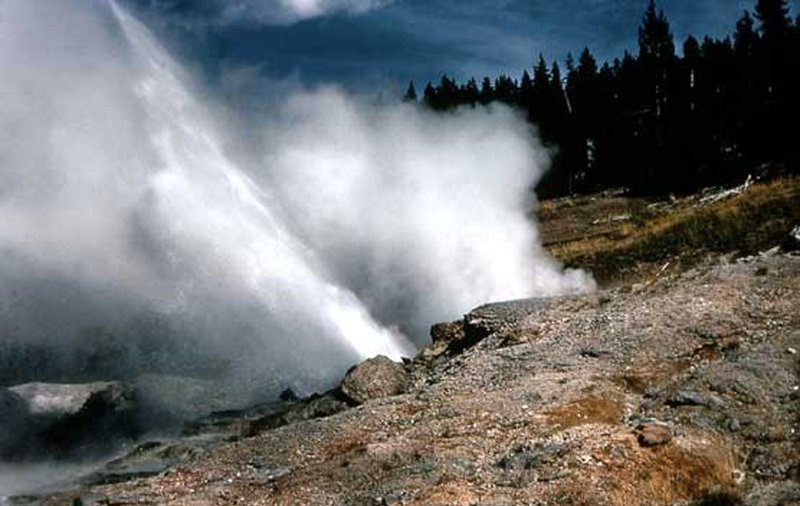YELLOWSTONE NATIONAL PARK, Wyo.—A noisy geyser in Yellowstone National Park has roared back to life after three years of quiet.
Ledge Geyser is one of the biggest in Yellowstone’s Norris Geyser Basin.
The Billings Gazette reports the geyser shoots hot water at an angle up to 125 feet high and a distance of 220 feet.
Yellowstone geologist Jeff Hungerford says Ledge Geyser is noisy because its water and steam must pass through a narrow opening in the ground.
Yellowstone has 1,300 thermal features and 500 geysers, more than anywhere else on Earth. Some geysers such as Old Faithful are predictable but most, like Ledge Geyser, erupt erratically.
Why Are Geysers Getting More Active?
Geologists have said that geysers at Yellowstone National Park have been getting more active in the past year or so.
“It’s a good lesson in how geysers actually work,” Michael Poland, the scientist-in-charge at Yellowstone Volcano Observatory told National Geographic on Feb. 19. “As soon as you start to recognize a pattern, it changes.”
The upsurge in geyser activity is taking place at the Norris Geyser Basin.
Poland, in the interview, made note of the Steamboat Geyser coming back to life in 2018. The Observatory said the geyser broke its all-time record by erupting 32 times last year.
“As geysers go, Steamboat is sort of typical in terms of having these sporadic, unpredictable eruptions,” Poland told the magazine. “But because it’s this really tall geyser and it has this name recognition, it makes it that much more interesting.”
Other geysers like Ear Spring, which is generally inactive, erupted and jettisoned trash from the 1930s.

Also, Giant Geyser, in another part of Yellowstone, has also been erupting more often in recent months.
“But back in 2007 to 2008, Giant went bananas,” Poland stated. “It erupted many, many more times than it had in the past year—and Steamboat didn’t do anything of the sort.”
Poland stressed there has been no change in the underlying heat source, and there have been no major geological changes.

“What absolutely isn’t worth speculating about is the state of Yellowstone’s infamous volcanic system. Any uptick in any sort of activity at Yellowstone seems to spark fears about a catastrophic eruption of the park’s huge caldera, even though such worries are unfounded,” said National Geographic, citing Poland.
He also said there has been no change in the magma reservoir that lies beneath Yellowstone over the past few years, despite alarmist headlines from British tabloids.
The geysers, he noted, also have nothing to do with the magma that lies many miles beneath the surface of the earth. The geysers are located on the top of the Earth’s crust.
“Steamboat Geyser … appears to have entered a phase of more frequent water eruptions, much like it did in the 1960s and early 1980s,” said the Observatory on its website. “Although these eruptions do not have any implications for future volcanic activity at Yellowstone (after all, geysers are supposed to erupt, and most are erratic, like Steamboat), they are nonetheless spectacular, and many people had a chance to see Steamboat in eruption during the summer of 2018.”
The last one was on Feb. 16, 2019.
Ear Spring Trash
Ear Spring’s eruption launched a number of items into the air, including a 1930s pacifier, dozens of coins, and a warning sign.
“On September 15, 2018 Ear Spring erupted and ejected lots of decades-old trash,” Yellowstone officials said on Facebook. The last significant Ear Spring eruption was in 1957, the U.S. Geological Survey said.
“Foreign objects can damage hot springs and geysers. The next time Ear Spring erupts we hope it’s nothing but natural rocks and water,” park officials wrote on Facebook. “You can help by never throwing anything into Yellowstone’s thermal features!”
An anonymous supervisory park ranger told FourStatesHomePage.com: “You might think that if you toss something in a hot spring or in a geyser that it disappears, but it doesn’t disappear.”
Those items remain inside the geyser and might plug it up.
“That’s happened in many places in the park,” the ranger stated.

Epoch Times reporter Jack Phillips contributed to this report.


